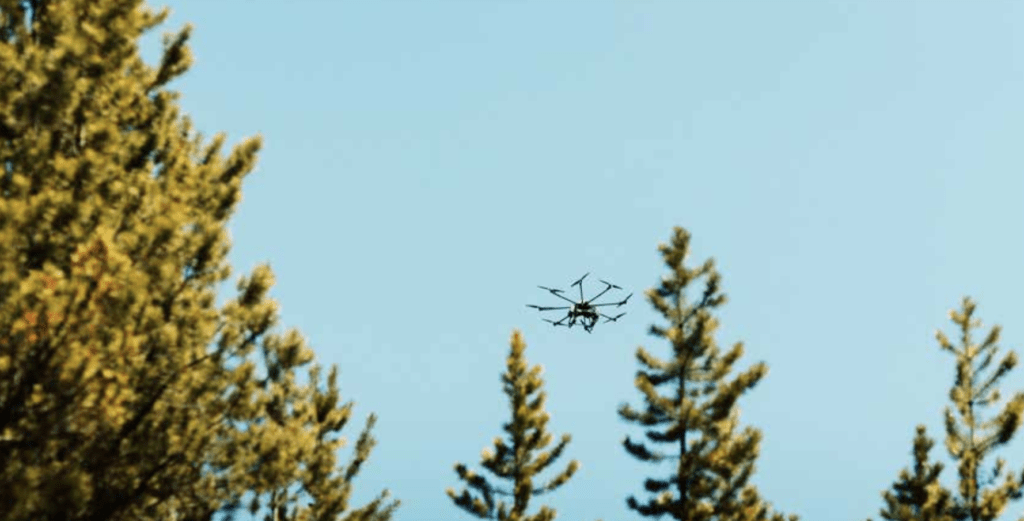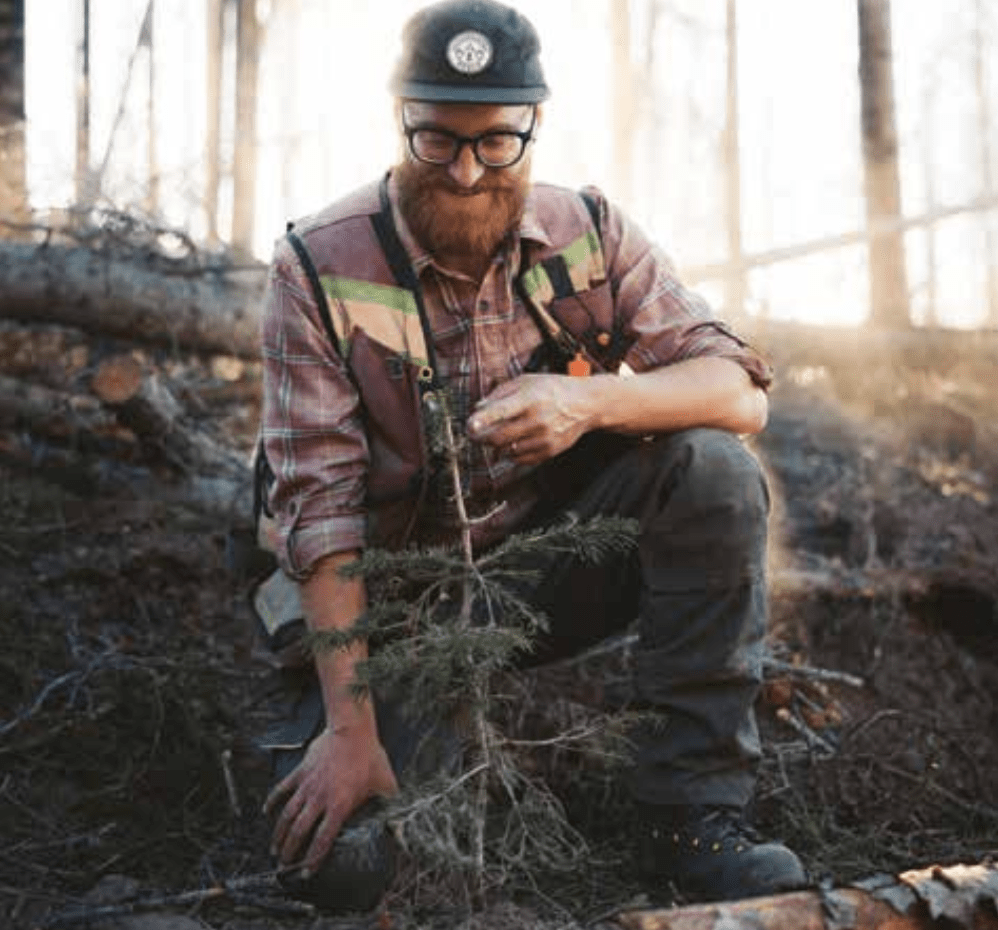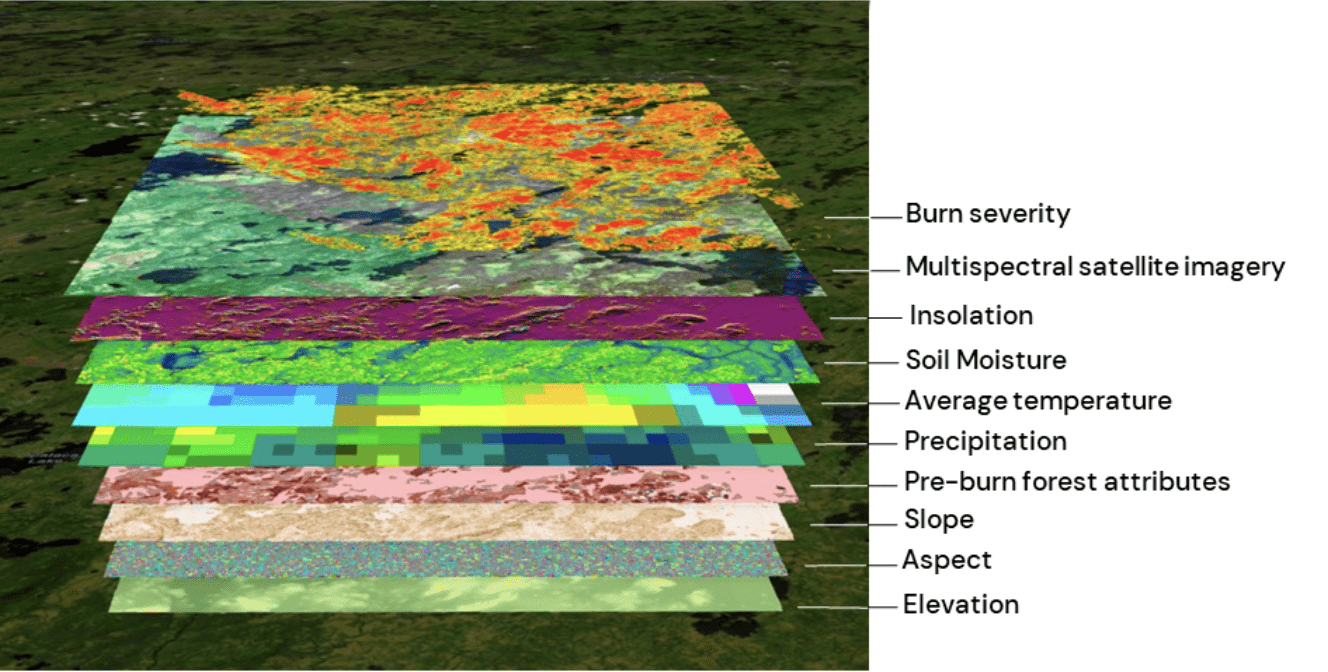Reforestation for a Changing World
 Flash Forest plans to plant a billion trees in Canada by the end of the decade/Flash Forest
Flash Forest plans to plant a billion trees in Canada by the end of the decade/Flash Forest
By Bryce Jones and Angelique Ahlström
September 16, 2024
Forests respond to wildfires in ways one can’t always predict, but how humans respond is paramount. Canada’s boreal forest is one of Earth’s four largest terrestrial carbon storehouses, yet is now experiencing record-breaking fires that compromise it. In 2023, over 17 million hectares of forest burned in Canada–six times the 10-year average–accounting for 43% of humans displaced by wildfires globally. Beyond demographic impacts on exposed and vulnerable populations, severe wildfires hinder the lifeline of critical ecosystems that help regulate the biosphere. The future trajectory and impact severity of Canadian wildfires remain uncertain. However, the outcome will depend on a combination of factors, including fire management, approaches to nature restoration, and policy decisions on technology adoption, all of which shape how Canada adapts to the new “Pyrocene” — fire historian Stephen Pyne’s term for this epoch of increased fire activity.
Forest Change and Reforestation
Wildfires in a warming climate are changing the overall shape and composition of Canada’s forests and reducing tree cover in areas failing to naturally recover. Black spruce, for example, show decreased recovery rates and shift their composition towards deciduous trees. After 10-16 months on the ground, their seed loses viability. If no germination occurs one year after a fire event, regeneration chances are low. More frequent fires also lead to mortality of younger stands, leaving less seed available after fires. You can see how this feedback loop unfolds. There remains a large and increasingly unmet but crucial need to reforest severely burnt stands in Canada.
Limits of Tree Planting

Traditional planting remains foundational to Canada’s forestry industry
(Flash Forest employee shown) —Flash Forest
Tree planting using the traditional hand-and-shovel method is arduous, important work. The value it provides to Canada’s forests and economy is significant.. There are three main challenges facing traditional planting: 1) Tree planter availability, 2) Safety, and 3) Scalability.
- Forestry experts have consistently communicated that it’s getting increasingly difficult to source tree planters to meet the annual reforestation demand.
- Tree planting is known for its physical demands and challenging conditions.Burn sites present additional challenges – including hazard trees, pointed snags, ground cavities, and carbon dust, which can sometimes make these areas legally restricted for planting. Despite these challenges, tree planting remains a vital activity for forest restoration.
- Tree planters have a biological limit to scale. On average, a human plants somewhere in the order of 2,000 seedlings per day. Without technological advancements, significantly higher planting scales using traditional planting methodology can only be achieved by hiring more planters.
One existing alternative to traditional planting is known as “seed broadcasting” or “aerial seeding” (commonly mistaken for “seedpod planting” by drone), and involves the indiscriminate scattering of seeds by helicopter or plane. A requirement of 100,000 seeds per hectare is not uncommon. A key issue with this approach is that seed waste rates of 95 to 99% (due to seed misplacement, desiccation and predation) are making seed broadcasting more and more untenable.
Flash Forest
Flash Forest was co-founded in 2019. Having worked in the tree-planting industry years prior and witnessed the lack of technology available for reforestation in addition to observing the impacts of wildfires experienced in our BC backyards, the founders saw the urgent need for more advanced solutions to address large-scale forest loss in Canada. The mission of Flash Forest was set to accelerate forest restoration at scale using new technologies, with a target of one billion trees by the end of the decade.
Technological Alternative
Over the past five years, Flash Forest has been developing solutions with the intent of addressing the above concerns within Canadian forestry with a viable technological alternative. After four years of trials across Canada, the planting of millions of pods and hand-collected data on failed and successful projects, Flash Forest recognizes that (1) site-selection and (2) species-selection remain two of the most crucial drivers of a successful reforestation/afforestation effort. Land conversion from wildfires and drought is also altering the species-mix required for long-term survival of forests. As of this year, Flash Forest has built a deep-learning model which takes historical germination and survival data from our planting efforts and correlates it with environmental and climatic factors to predict suitability for our approach.
Within Flash Forest’s tech suite, these are the primary innovations brought to our projects: 1) Biodegradable Seedpod Technology, 2) Seedpod Embedment, 3) Manufacturing Automation and 4) AI Software models for site selection.
- Seedpods contain a combination of bioavailable nutrients, minerals and a symbiotic microbiome (19 mycorrhizal and 2 bacterial inoculants), promoting several key benefits, including germination and survival improvements, and reduction of seed waste from desiccation and predation. Designed to support seedling growth during periods of heat and drought, upon first contact with rain, the seedpods expand to approximately 400% in volume, increasing the water holding capacity of the microsite that envelops the seedling.
- Rather than planting seedlings by hand or scattering seeds, Flash Forest mechanically ‘embeds’ seedpods into soils using payload systems mounted to UAVs. The hard protective shell of the seedpods enables soil penetration and shields seeds from predation.
- Flash Forest’s seedpod production facilities, based out of Mississauga, Ontario, have achieved substantial efficiencies at scale, where currently 450,000 seedpods are produced per day. Daily throughput is expected to reach one million seeded pods per day by Q4 2024. Flash Forest’s six-month seedpod production value chain allows for quick response time to wildfire disturbances. It also allows for the nursery phase to be bypassed, requiring less water, space and energy, which reduces GHG emissions over the convention.
- Flash Forest’s site suitability AI (deep learning) model, using real-time satellite imagery, analyzes environmental indexes (e.g. solar radiation, soil moisture, mean summer precipitation, etc.) that allow for selections of regions with the highest probability of planting success. This list of environmental and climatic factors has been exhaustively collected and modeled alongside Flash Forest’s planting data to allow for macro and micro-site targeting. Flight path generation models trained on AI help optimize flight routes to maximize survival and species selection, while minimizing seedpod wastage on areas that are not mineral soil (e.g. roads, water, slash piles, etc.) or areas that have natural regeneration.

Flash Forest’s AI model assesses site selection factors for drone reforestation
Flash Forest’s process includes initial seed viability tests in Flash Forest’s greenhouse facilities, suitability model-informed site selection through satellite data, end-to-end drone-based reforestation service, and post-monitoring and evaluation of germination and survival over several seasons post-plant. Flash Forest contracts out local cone collectors to achieve the required seed supply and ensure seedbanks of partners are not depleted. As of today, Flash Forest has anchored a specialization in boreal forest wildfire restoration, operating in six provinces, and has now expanded internationally in response to growing demands for its innovations, with client verticals spanning forestry, carbon, government, NGOs, and the corporate sector.
Not a Silver Bullet
In no Canadian sector are the effects of climate change felt more strongly than in forestry. We need to re-think how forests are managed and how reforestation is engaged to adapt to a changing climate. New technologies, such as drone reforestation, hold promise for large-scale forest restoration efforts. They offer solutions to help meet this increasing demand in Canadian forests and beyond. Flash Forest is now actively expanding its operations with international partners in response to strong global interest in its innovations.
Within Canada, policymakers and provincial forestry ministries, landowners and private forestry companies must recognize that the new technologies coming down the line are not a threat, but an asset to the domestic forestry industry. These technologies offer benefits of cost reduction, safety improvements, and increased scalability potential. They can also enhance long-term forest health through data-driven AI models, informing optimal site selection and forest biodiversity enhancement.
It’s important to note that these new forest technologies are not a silver bullet for reforestation, nor are they the best solution for all reforestation needs. Traditional planting will remain foundational in Canada’s forestry industry into the foreseeable future. Drone-based and other new automated forest technologies are to be seen as a viable supplement to existing traditional practices, such as in severely burnt post-wildfire forests too dangerous or remote for traditional planting, or in areas which struggle to regenerate naturally. New and conventional methods together will enable meeting the increased scales and pledges required by corporations and federal governments, driven by our changing world.
Bryce Jones is founder and CEO of Flash Forest.
Angelique Ahlström is co-founder and Head of Global Forestry at Flash Forest.
